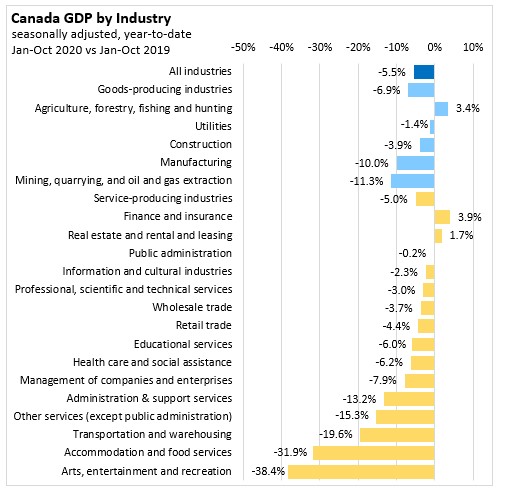The Economics and Statistics Division maintains archives of previous publications for accountability purposes, but makes no updates to keep these documents current with the latest data revisions from Statistics Canada. As a result, information in older documents may not be accurate. Please exercise caution when referring to older documents. For the latest information and historical data, please contact the individual listed to the right.
<--- Return to Archive
For additional information relating to this article, please contact:
December 23, 2020CANADA GDP BY INDUSTRY, OCTOBER 2020 Real Gross Domestic Product (GDP) in Canada increased 0.4% in October following a 0.8% increase the previous month. The continued increase in real GDP for the past six months offset some of the losses observed in March and April 2020. However, real GDP in Canada is still 4.0% below the February 2020 pre-pandemic level.
In October 2020, the Canadian economy is 3.5% smaller compared to October 2019 with an annualize value of $1,920 billion (chained 2012 dollars).
Statistics Canada’s preliminary estimate for real GDP points to an approximate 0.4% increase in November 2020. The official GDP data for November will be released on January 29, 2021.


Goods-Producing Industries
Goods-producing sector output increased 0.1% month-over-month in October 2020. Output in all sub-sectors except manufacturing were up in October.
Agriculture, forestry, fishing, and hunting activity was up 1.6% in October posting the third consecutive monthly gain. October’s higher output level was primarily due to increased crop production supported by elevated grain and cannabis production.
The manufacturing sector output declined 0.8% after five consecutive months of growth as gains in non-durable manufacturing were not able to offset declines seen in durable manufacturing. The decline in October was mostly a result of lower inventory formation.
Durable manufacturing output showed a decline of 2.5% in October with lower activity in transportation equipment (-3.7%), machinery (-4.1%) and fabricated metal product manufacturing (-3.5%). Gains were seen in wood products (+2.8%) and miscellaneous manufacturing (+1.7%). Non-durable manufacturing output increased 1.2%, led by petroleum and coal products (+6.5%) and plastics and rubber products (+4.3%).
Construction GDP increased 0.7% in October following a 0.6% decline in the previous month. Residential construction increased 1.9% in October, registering the sixth consecutive monthly gain. The increased activity in residential construction was due to higher activity in single-unit and multi-unit dwelling construction. Non-residential construction output declined 2.1% with lower activity in commercial, industrial and public construction.
Mining, quarrying, and oil and gas extraction was unchanged in October. Oil and gas extraction output increased 1.2%, posting the second consecutive gain. Mining and quarrying output declined 3.7% due to lower activity in potash mining (-25.1%) and metal ore mining (-1.8%). Coal mining activity was up 13.0% in October.
Services-Producing Industries
Output of services-producing sector increased 0.5% in October 2020.
The public sector (educational services, health care and social assistance, and public administration) grew 0.7% this month with higher activity in all three components. Educational services output was up 0.9% in October posting the sixth consecutive monthly gain. Public administration was up 0.4% in October. Health care and social assistance posted an increase on 0.9% despite a small decline in hospitals (-0.5%).
Professional services were up 1.0% with computer systems design and related services leading the growth with a 1.1% increase in October. This industry has been on an upward trend since November 2016 with the exception of declines in March and April 2020. Activity was also up in legal services (+1.8%), management, scientific and technical consulting services (+1.6%) and architectural, engineering and related services (+0.8%).
Accommodation and food services declined 3.9% in October as the momentum from the re-opening of economy started to slow down. With tighter restrictions in a number of provinces to limit the spread of the second wave, the output in food services and drinking places declined 4.5% in October. Statistics Canada noted that this was the largest monthly decline in this sector since January 1991 aside from the declines seen in March and April.
Retail trade increased 0.3% while wholesale trade was up 0.8% in October 2020. In October 2020, retail trade is 2.5% above pre-pandemic February 2020 levels while wholesale trade is 0.7% below its pre-pandemic level.
Transportation and warehousing increased by 0.8% with gains in by pipeline transportation (+2.9%) of both oil and natural gas and support activities for transportation (+1.7%). Declines were seen in truck transportation (-0.8%) and postal service, couriers and messaging services (-1.1%).

Year-to-Date (Jan-Oct 2020 vs. Jan-Oct 2019)
The Canadian economy in the first ten months of 2020 declined 5.5% compared to the same period in 2019.
Amid the COVID-19 pandemic and economic recovery, the largest declines in activity have been in arts, entertainment and recreation (-38.4%), accommodation and food services (-31.9%) and transportation and warehousing (-19.6%). Finance and insurance (+3.9%), agriculture, forestry, fishing and hunting (+3.4%) and real estate and rental and leasing (+1.7%) have grown in 2020.

Source: Statistics Canada, Table 36-10-0434-01 Gross domestic product (GDP) at basic prices, by industry, monthly (x 1,000,000)
<--- Return to Archive